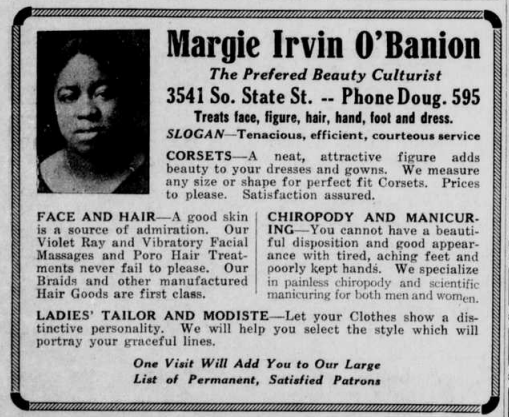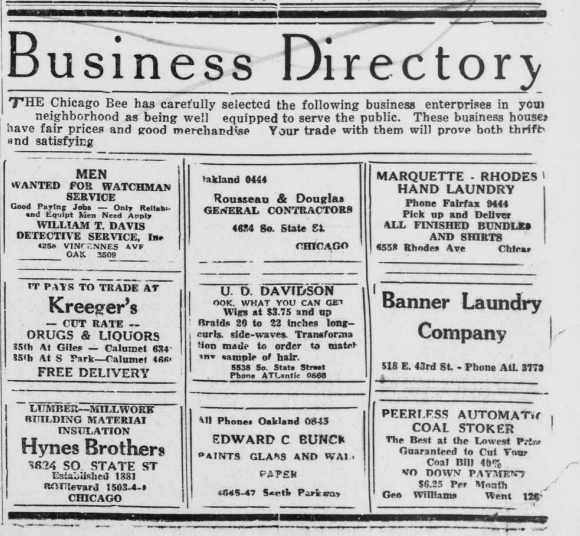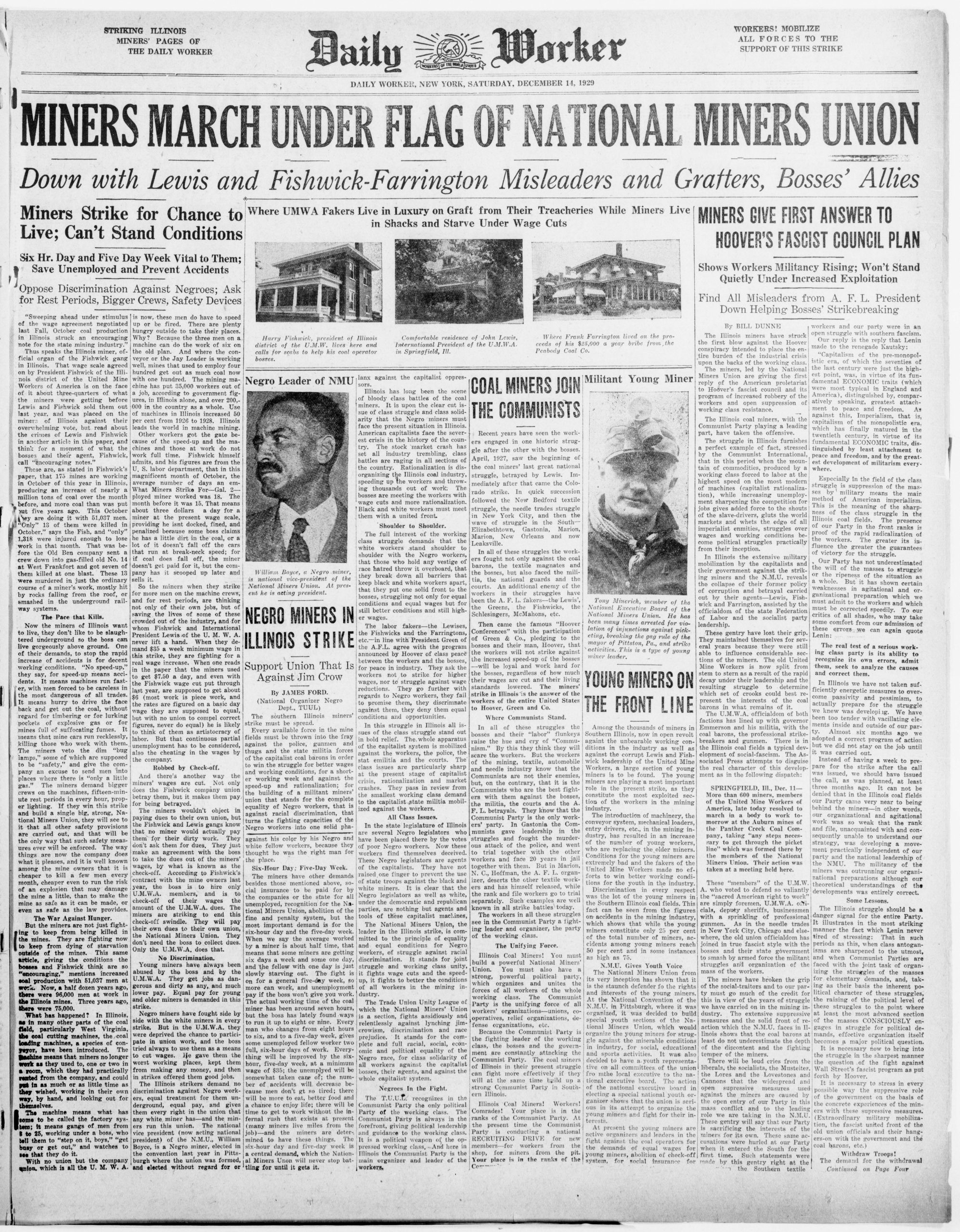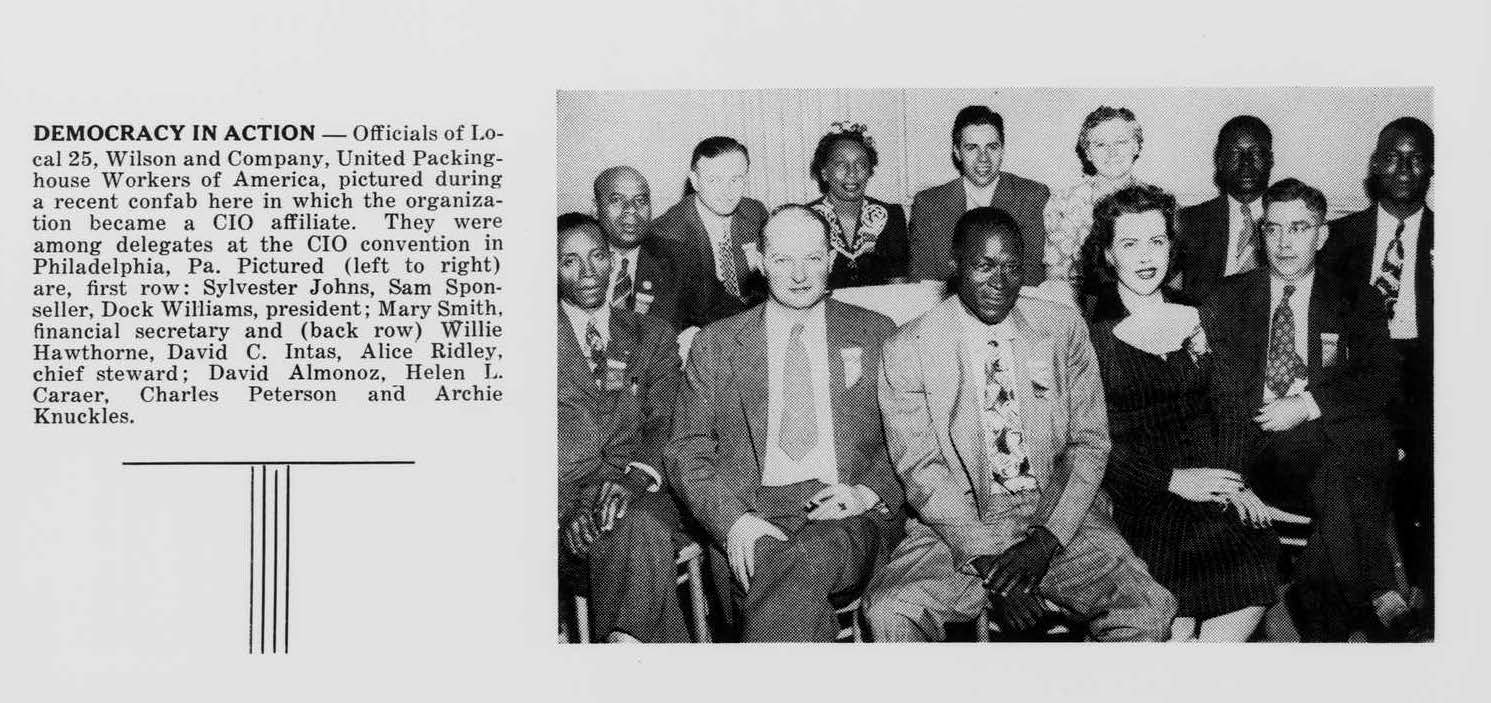The Black Press

In honor of Black History Month, the Illinois Newspaper Project (INP) is using the Illinois Digital Newspaper Collection (IDNC) to understand Black labor history (rights, unions, and movements) and Black-owned business in Illinois through historical newspapers. We’re highlighting the mastheads of (and people behind) Black newspapers as well as advertisements for Black-owned businesses found within newspapers. A special photograph issue (published December 5, 1943) of the Chicago Sunday Bee specifically highlights Willard S. Townsend, a Black labor leader and first African-American to hold office in a national union, and printed photographs of Black labor leaders present at a Congress of Industrial Organizations (CIO) meeting in Philadelphia.
Did you know that the Illinois Digital Newspaper Collections (IDNC) has a collection of Black newspapers? In order to preserve the cultural and print heritages of Black papers and their readers, the Illinois Digital Newspaper Project (IDNP) has centered past digitization projects around historical Black newspaper printed (primarily) in Illinois.
Black Newspapers Collection: Black owners, editors or publishers
The Black Newspapers Collection collection includes newspapers that were owned by, operated by, or intended for Black readers and communities. Titles in the Black Newspapers Collection focus on the 20th century, but range from 1897 (the only surviving issue of the Chicago Reflector) to 2003 (the Lincolnian). To read more about the history of any of these titles, click the links to view their newspaper title essays.
- The Broad Ax (Chicago, Ill.) || Digitized content: August 31, 1895 – September 10, 1927 (1661 issues)
- The Chicago Illinois Idea (Chicago, Ill.) || Digitized content: October 28, 1916 (1 issue — only surviving issue on record)
- The Chicago Reflector (Chicago, Ill.) || Digitized content: October 16, 1897 (1 issue — only surviving issue on record)
- The Chicago Whip (Chicago, Ill.) || Digitized content: June 24, 1919 – October 10, 1931 (177 issues)
- The Forum (Springfield, Ill.) || Digitized content: February 3, 1906 – June 30, 1917 (395 issues)
- The Free West (Chicago, Ill.) || Digitized content: December 1, 1853 – July 19, 1855 (77 issues)
- The Illinois Star (Galesburg, Ill.) || Digitized content: July 4, 1935 – November 6, 1941 (6 issues)
- The Illinois Times (Champaign, Ill.) || Digitized content: October 14, 1949 – September 20, 1963 (132 issues)
- Metropolis Weekly Gazette (Metropolis, Ill.) || Digitized content: July 21, 1911 – December 22, 1922 (426 issues)
- Metropolitan News (Chicago, Ill.) || Digitized content: May 7, 1935 – February 27, 1937 (12 issues)
- Sunday Chicago Bee (Chicago, Ill.) || Digitized content: May 1, 1938 – October 20, 1946 (12 issues)
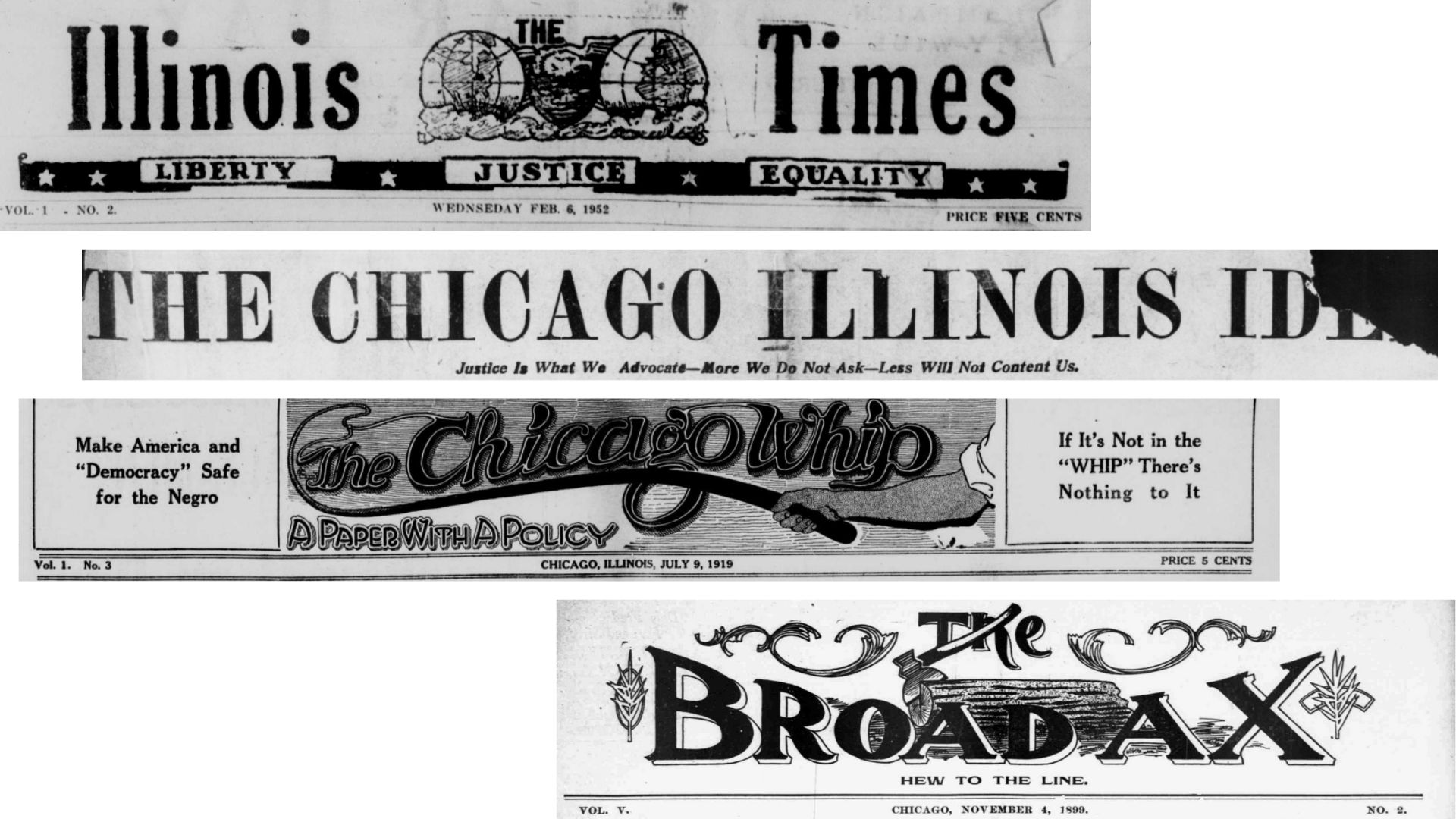
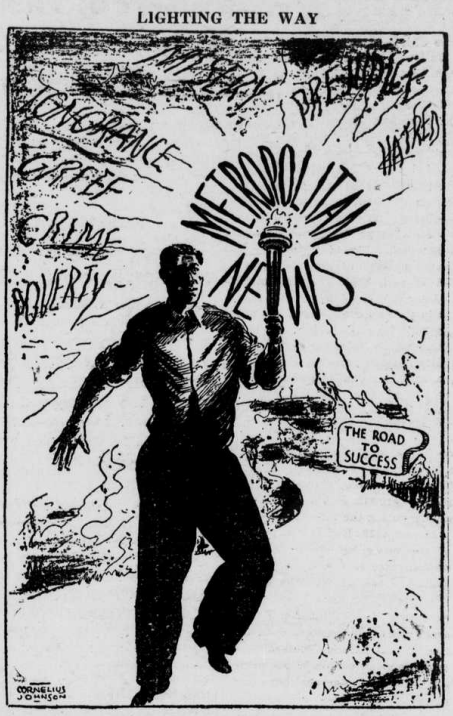
The image on the left is a clipping from the Metropolitan News, a Black-owned newspaper published in Chicago, Illinois, from 1935-1938. The sketch is an advertisement for the newspaper as a means of “lighting the way” toward peace and equality.
The Black Newspapers Collection also includes the college newspaper, the Lincolnian (continued as the Lincoln News), from Lincoln University, an HBCU in Pennsylvania, as well as historical abolitionist newspapers, the Western Citizen, Genius of Liberty, and Genius of Universal Emancipation. For other newspapers with Black readership, check out the The Robbins Eagle, published in Robbins, Illinois, a town popular with African Americans in the early 1900s.
Researching Black labor history
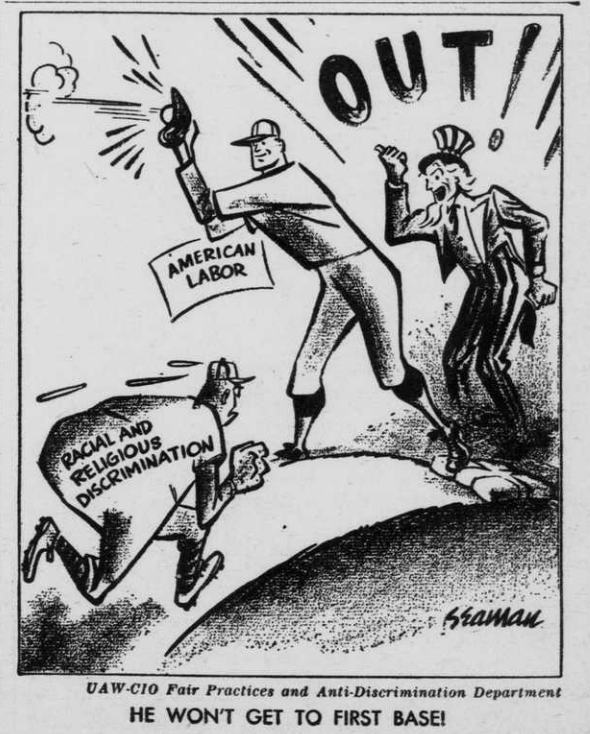
Much of my keyword searching in the Illinois Digital Newspaper Collections (IDNC) used words such as “labor” or “unions” AND “negro” or “colored” — keeping in mind that when researching historical material, using historical terminology generates better results.
Because I wanted to focus on Black laborers and labor leaders, I kept my searches to the Black Newspapers Collections. I found articles about several unions and labor organizations with Black members and leaders, for example:
- National Association of Negro Musicians
- Negro Publishers Association
- National Negro Press Association
- National Negro Insurance Association
- National Negro Business League
- Brotherhood of Sleeping Car Porters
- Bartenders and Waiters Union
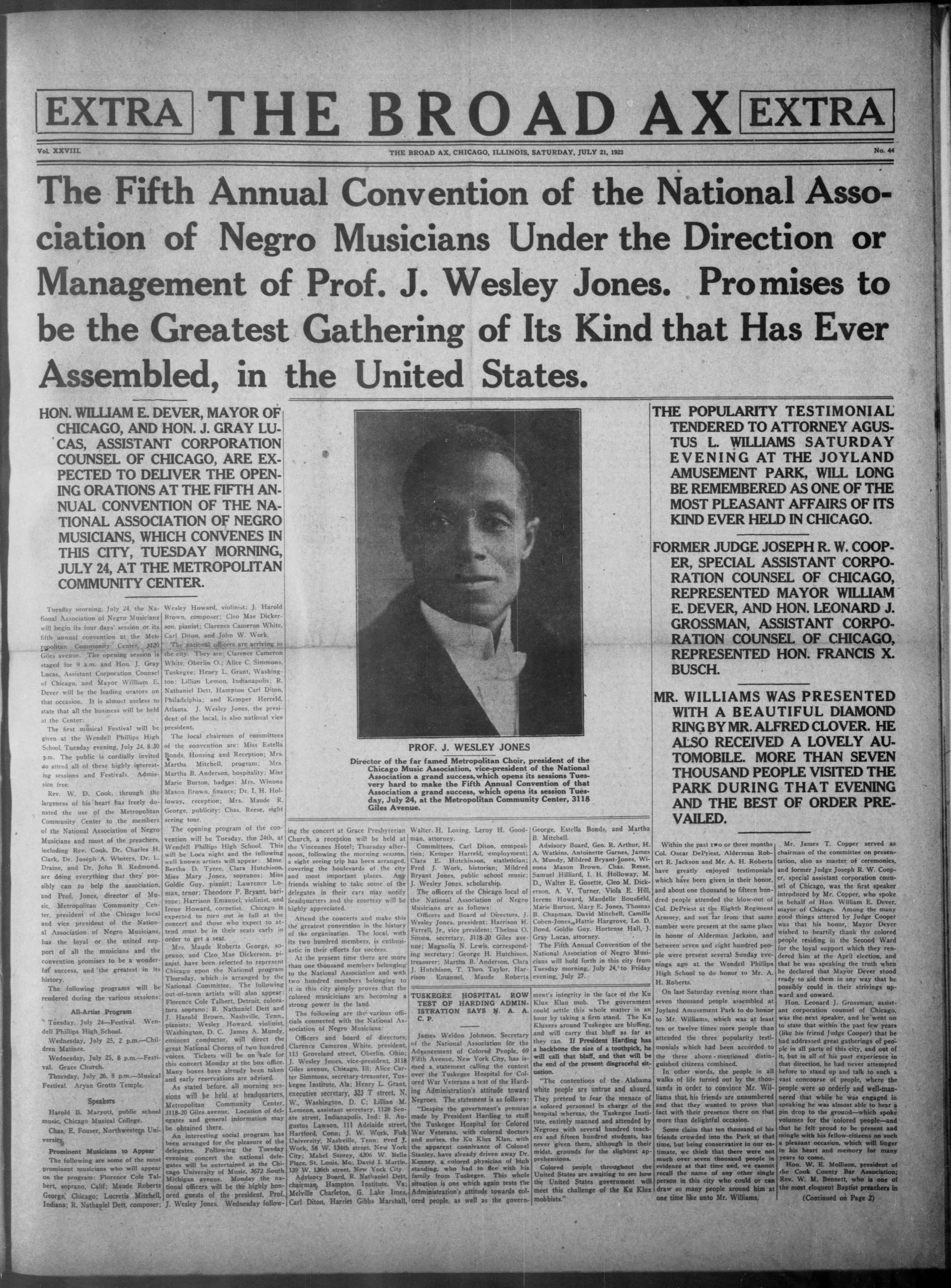
By the late 1920s, Black labor leaders slowly gained momentum, creating their own labor organizations and securing allyship with progressive white labor leaders. There is a vast amount of IDNC articles detailing the racial inequality of labor history, and not just within the Black Newspapers Collection. Searching all of the IDNC will retrieve articles of varying views, depending on the publication. The below image is from the December 14, 1929, issue of the Daily Worker, a newspaper of the Communist Party USA. The Daily Worker published progressive articles about labor and racial equality within the labor force. Click the below image to read about mining unions, such as the United Mine Workers of America and the National Miners Union, which had a Black miner as its vice president.
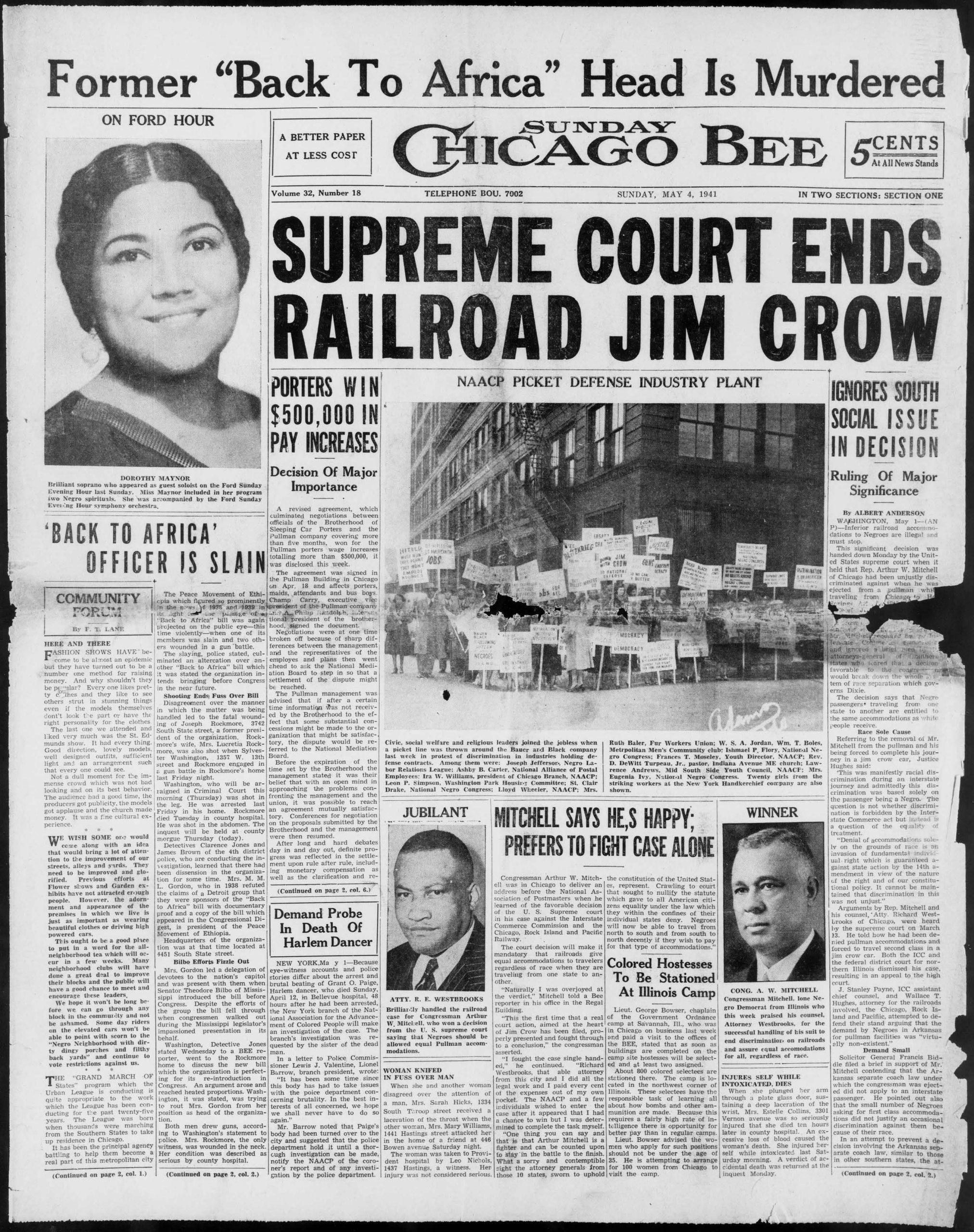 Moving on in my search, I found many articles about the Brotherhood of Sleeping Car Porters, given the Chicago locale of the Pullman Company and the rail system’s prominence in Chicago, Illinois. This front page of the May 4, 1941, issue of the Sunday Chicago Bee (Chicago, Ill.) announces the Supreme Court ending Jim Crow in the railroad industry. Other columns on the font page include a pay increase negotiated by the Brotherhood of Sleeping Car Porters and the Pullman Company, and an image of labor and civic leaders picketing “the Bauer and Black company in protest of discrimination in industries holding defense contracts.” Click the image to enlarge.
Moving on in my search, I found many articles about the Brotherhood of Sleeping Car Porters, given the Chicago locale of the Pullman Company and the rail system’s prominence in Chicago, Illinois. This front page of the May 4, 1941, issue of the Sunday Chicago Bee (Chicago, Ill.) announces the Supreme Court ending Jim Crow in the railroad industry. Other columns on the font page include a pay increase negotiated by the Brotherhood of Sleeping Car Porters and the Pullman Company, and an image of labor and civic leaders picketing “the Bauer and Black company in protest of discrimination in industries holding defense contracts.” Click the image to enlarge.
IDNC SEARCH TIP: Using search facets, such as those on the left sidebar on the IDNC search page, makes your searching more manageable. You can facet your keywords searches to specific decades, years, counties, newspaper titles, or IDNC collections.
Congress of Industrial Organizations (CIO)
A special issue of the Chicago Sunday Bee (Chicago, Ill.), published December 5, 1943, features a full-page cover image of Willard S. Townsend, “CIO’s Great Negro Leader.” The entire issue is dedicated to the CIO, and detailed, with photographs, the Sixth Constitutional Convention of the Congress of Industrial Organizations (CIO), held in Philadelphia from November 1-6, 1943.
Pictured above: Front page of the December 5, 1943, issue of the Sunday Chicago Bee (left), p.2 (right), excerpt from p.12 (bottom). To read the full pictorial issue, click here.
Black-owned Businesses
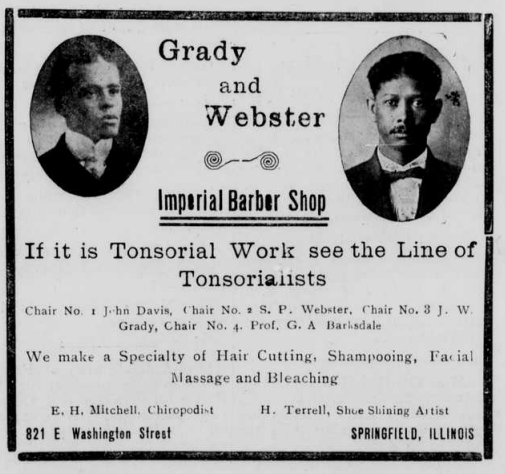 While browsing issues in the Black Newspapers Collection, I made note of what types of advertisements were printed. Several were explicitly Black-owned businesses, but other ads were for businesses who supported racial equality and welcomed Black customers. Below, I’ve highlighted ads from Black-owned businesses in Champaign, Springfield, and Chicago, Illinois.
While browsing issues in the Black Newspapers Collection, I made note of what types of advertisements were printed. Several were explicitly Black-owned businesses, but other ads were for businesses who supported racial equality and welcomed Black customers. Below, I’ve highlighted ads from Black-owned businesses in Champaign, Springfield, and Chicago, Illinois.
The image on the left is a clipping of an advertisement for Grady and Webster’s Imperial Barber Shop, 821 E. Washington St., Springfield, Ill. published in the July 16, 1910 issue of The Forum, a Black newspaper published in Springfield, Illinois. The Forum was a weekly newspaper that printed from 1904-1927. While published in Springfield for the majority of its run, the Forum was published in Peoria between August 15, 1914 to July 1, 1916, then in both cities after August 15, 1914. Prior to 1917, the paper was published with Elmer Lee Rogers (1877-1957) as editor and manager. After the February 10, 1917 issue, activist Zedekiah (“Z.W.”) Mitchell (1867-1930) was named editor. Mitchell established the “Colored Social Center” in Springfield in 1918
Featured above is a collage of advertisements from Black-owned businesses in Champaign-Urbana, Illinois, all advertised in the Daily Illini, the student-run newspaper of the University of Illinois Urbana-Champaign. The featured advertisements are for Jordan’s Sanitary Barber Shop, 36 Main St., Champaign, from the January 24, 1917, issue; Shelton Laundry service (Urbana, Ill.), from the September 22, 1955 issue; and an advertisement for afro wigs from Johnson Distributing Company, 1411 West Eads, Urbana, from the January 4, 1970 issue. To read more about Shelton Laundry, visit the Urbana Businesses entry of the Champaign County African American Heritage Trail website.
Undertaking (mortuary) businesses were fairly common in newspaper advertising, and ads for this businesses typically always featured a portrait of the business owner. Below are two advertisements I found from Black-owned undertaking companies. Ernest H. Williamson placed advertisements in several Chicago-area Black-owned newspapers. This clipping below is from the Chicago Illinois Idea (Chicago, Ill.) printed October 28, 1916. The advertisement for McCrary’s Undertaking, from Massac County in Southern Illinois, was printed in the Metropolis Weekly Gazette, a Black-owned newspaper published in Metropolis, Illinois.
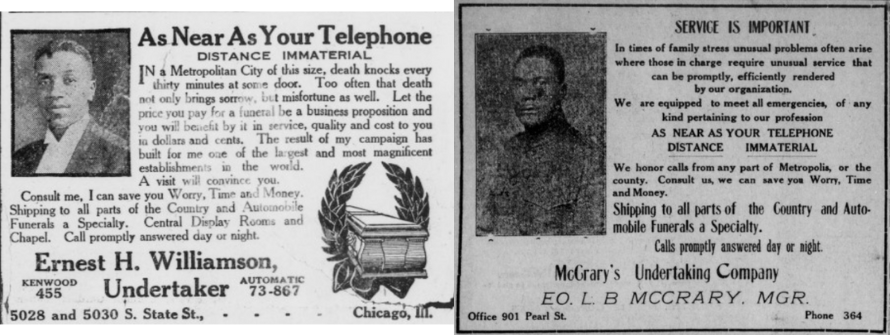
I’ll end this blog post with a few more clippings of interest to Black-owned businesses:
